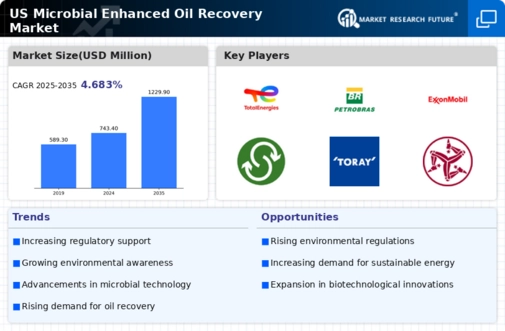Rising Energy Demand
The increasing energy demand in the United States is a primary driver for the microbial enhanced-oil-recovery market. As conventional oil reserves deplete, the need for alternative recovery methods becomes more pressing. The U.S. Energy Information Administration (EIA) projects that energy consumption will rise by approximately 10% by 2030. This trend necessitates innovative solutions to maximize oil extraction from existing fields. Microbial enhanced-oil-recovery techniques offer a promising avenue to enhance oil recovery rates, potentially increasing production by 5-15%. As energy companies seek to meet this growing demand, investments in microbial technologies are likely to escalate, further propelling the market forward.
Environmental Regulations
Stringent environmental regulations in the United States are significantly influencing the microbial enhanced-oil-recovery market. The U.S. government has implemented various policies aimed at reducing greenhouse gas emissions and promoting sustainable practices in the oil industry. These regulations encourage the adoption of environmentally friendly recovery methods, such as microbial techniques, which minimize ecological impact compared to traditional methods. The Environmental Protection Agency (EPA) has noted that microbial enhanced-oil-recovery can reduce the carbon footprint of oil extraction processes. As companies strive to comply with these regulations, the microbial enhanced-oil-recovery market is expected to experience growth, as firms seek to align with sustainability goals while maintaining profitability.
Technological Integration
The integration of advanced technologies into the microbial enhanced-oil-recovery market is a notable driver of growth. Innovations in biotechnology, data analytics, and monitoring systems are enhancing the efficiency and effectiveness of microbial recovery methods. For instance, the use of genomic sequencing allows for the identification of specific microbial strains that can optimize oil recovery. Additionally, real-time monitoring technologies enable operators to assess the performance of microbial treatments, leading to improved decision-making. As the oil industry increasingly embraces digital transformation, the microbial enhanced-oil-recovery market is likely to benefit from these technological advancements, potentially increasing recovery rates by up to 20%.
Investment in Research and Development
Investment in research and development (R&D) is a crucial driver for the microbial enhanced-oil-recovery market. The U.S. oil industry is allocating substantial resources to explore innovative microbial solutions that can enhance oil recovery. According to the American Petroleum Institute, R&D spending in the oil sector has seen a steady increase, with estimates suggesting a rise of 8% annually. This investment is aimed at developing new microbial strains and optimizing existing processes to improve recovery efficiency. As companies recognize the potential of microbial technologies to unlock additional reserves, the microbial enhanced-oil-recovery market is poised for growth, driven by ongoing advancements in R&D.
Economic Viability of Enhanced Recovery
The economic viability of enhanced oil recovery methods is a significant factor driving the microbial enhanced-oil-recovery market. As oil prices fluctuate, the need for cost-effective recovery solutions becomes paramount. Microbial techniques, which can be less expensive than traditional methods, offer a compelling alternative for oil producers. The cost of implementing microbial enhanced-oil-recovery can be offset by the increased yield, with some studies indicating a potential return on investment of 150% within a few years. As oil companies seek to maximize profitability in a competitive market, the economic advantages of microbial recovery methods are likely to stimulate growth in the microbial enhanced-oil-recovery market.

















Leave a Comment